The New York State Archives are located on the Eleventh Floor of the Cultural Education Center, on Madison Avenue and off Empire Plaza, in Albany. Altogether, there are 148 total volumes in the collection of Admission Registers for Sing Sing Prison, covering more than a century of admissions from 1865 to 1971. The leather and cloth registers are fourteen inches long and nine inches wide.
Each page is entitled “RECEIVING BLOTTER” with “Sing Sing Prison”
printed beneath it. All entries and information about the inmates in the early volumes are hand written.
I arrived at the New York State Archives as the receptionist opened its doors. Twenty Inmate Admission Registers were sitting in two piles on a metal library cart near a table allocated to me for research. I had requested Registers for the period beginning in 1922 and ending in 1930.
Cultural Education Center:
Home of NYS Archives.
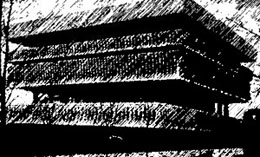
Above is a graphic pen sketch based on a color photo post card created by Dennis Mallory, one of several Albany region post cards he displays on his Webshots page. Mallory reports that from 1973 through 1986, he produced and distributed Albany area post cards using the name Avis Post Card Co.
Below is a map detail modified to show the proximity of the Cultural Education Center, home of the NYS Archives and State Museum, to the Empire State Plaza. The detail has been modified by the NYCHS webmaster from an excellent map of the plaza vicinity on the very user-friendly directions web page of the New York Network. NYN, a service of the State University of New York, operates a multi-studio production facility in Empire State Plaza, assisting in the creation and production of educational and instructional programs, documentaries and public service announcements.
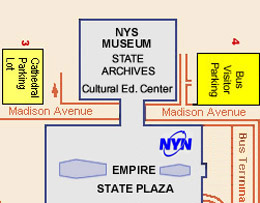
|
|
At nine thirty that morning, I started turning the pages of the first register. By noon, I was looking through the register for 1924 and thinking about a short break for lunch. I decided to finish the year and, fifteen minutes later, I turned to admitting number 76577, December 9, 1924, and saw the written name, “Gold, Harry N.” On the bottom of the page, I saw Dad’s signature, which changed little over the years. A shiver ran down my spine.
The Receiving Blotter related a few pertinent facts about my father. For first-degree robbery, he was sentenced by Judge Culkin of Bronx County to a prison term of seven to twenty years in Sing Sing. My dad confessed to the crime and was sentenced on December 5, 1924. He arrived in Ossining four days later, after serving a total of twenty-one days in jail from the time of his arrest, on November 19, 1924, to his incarceration at Sing Sing Prison. His anticipated parole date was set for February 16, 1930 and figured by hand on the bottom of the page.
I now knew my assumption that I was a second honeymoon child was wrong. My father was paroled twenty months before I was born - So much for thirty years of romantic fantasy.
I am not certain when my mother and father reunited after his parole from Sing Sing. Paroled in February, 1930, I do know my dad went to Newport, Rhode Island, where my mother remained after nursing her terminally ill mother (my maternal grandmother), who died in 1928.
My cousin, Janet Schleifer Tolsky, remembers my father's visit in Newport "to win my mother back to him" after the disgrace of his crime and imprisonment in Sing Sing. Janet recalls my dad taking her, my brother, and a couple of other cousins to see Al Jolson in The Jazz Singer. Eleven years old at the time, she knew my father took them to the "talky" in the winter of 1930 because she recalls wearing a heavy coat and then moving with her family to Brooklyn, New York the following fall.
The remainder of the information on the blotter obviously was supplied by my dad in answer to questions from a prison admissions officer. He gave his age as twenty-seven, his religion as Hebrew and his occupation as clerk. He said he was born in New York City which I knew was not true. Who knows how many times I had heard my grandmother tell the story of her arrival in the United States. My father was a baby in her arms when she entered New York Harbor and saw the Statue of Liberty through a porthole.
Sing Sing Receiving Blotter entries
for Inmate # 76577 Harry N. Gold
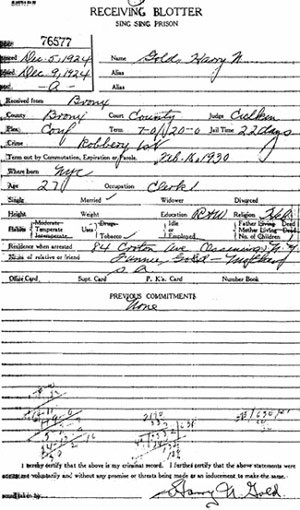
Above is an image of the Sing Sing Receiving Blotter page entry that his son copied in the State Archives, Albany.
Below is a detail section of that blotter page showing a Sing Sing officer's mathmatical calculations of Harry N. Gold's projected parole release date.
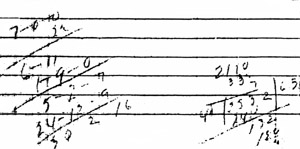
|
|
Not surprisingly, the relative my dad named as an emergency contact was my grandmother, Fannie Gold; his father was listed as dead. Though neither my mother nor brother were mentioned by name, his marriage was recognized and one child was cited. Dad’s local Ossining address (84 Croton Avenue) was included as well as the fact that his mother lived at the same address. The only other information checked on the blotter indicated he had been employed, could read and write, smoked and had temperate habits.
Quickly looking over the few facts written about my father on the Admissions Blotter, I knew why no record of his arrest, trial or conviction appeared in the sources I had seen. He was arrested for armed robbery in the Bronx and, although obviously a borough of New York City, the court records were preserved in its County Clerk’s Office, not in the Municipal Archives, where I had expected to find them. It had not occurred to me or to the knowledgeable staff of the Municipal Archives that the Bronx or any of the other city boroughs kept separate records from the past.
In the twenties, the New York Times also concentrated on news in Manhattan. Stories were written about the other four boroughs, especially Brooklyn, but the most populous borough understandably earned the newspaper’s emphasis and reportage. One robbery report in the Bronx, therefore, would be insignificant to the Times, when there were hundreds of crimes each month in Manhattan.
There was no mention of my dad’s arrest in Ossining’s Citizen Sentinel because the newspaper first appeared in print in January, 1925, three weeks after he arrived at Sing Sing. Another paper, the Democratic Register, was published in Ossining at that time, but has not been well preserved or microfilmed for research use. In the cellar of the Ossining Historical Society Museum building, it is beige with age and literally in bits and pieces. I started to look through the newspaper, but it fell apart in my fingers.
Once I knew the date of my dad’s trial, I phoned the Bronx County Clerk’s Office and asked about the existence of a criminal trial for Harry N. Gold, on December 5, 1924. I waited anxiously as my inquiry was eventually transferred to the microfilm room and then held my breath while Steven Kravitz looked through the index. “Yes,” he said, “It’s here - case number 776 for 1924 - nine pages in all. We can copy it and send it to you for 25 cents a page.”
A copy of Case # 776 arrived in the mail three days after I returned to my home in Florida. The case included the Grand Jury’s indictment, the trial, held on December 1, 1924, Dad’s guilty plea the next day, and his sentencing on December 5, 1924.
Harry N. Gold's case prosecutor
was judge in Bertrand Russell case.
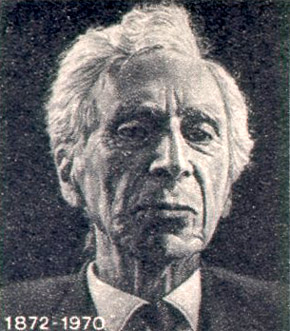
At the time of Harry N. Gold's arrest in 1924, John E. McGeehan was Bronx District Attorney. Therefore the robbery prosecution was brought in his name.
In 1933, McGeehan became a State Supreme Court Justice for NY's 1st District and served 17 years on that bench.
One of McGeehan's more notable decisions revoked the City College of New York board's spring 1940 appointment of Bertrand Russell to a teaching position in the phiosophy department.
The Briton's reputation and influence in the fields of mathematics and philosophy were and still are great. His advocacies in the arenas of public affairs and personal morality stirred controversies that also continue.
The appointment had set off a storm of protests citing Russell's published writings seen as endorsing conduct contrary to traditional moral values. A suit by the parent of a CCNY student was brought to invalidate the board's action.
Judge McGeehan ruled that Russell, who was not a citizen and had no application pending for citizenship, could not be appointed to the CCNY post under then existing law.
The judge also noted the absence of any search or competitive exam for qualified candidates to fill the position.
McGeehan sided with the petitioner parent's concerns about the impact that the appointment, given Russell's published views on moral issues, would have her daughter and other parents' children attending CCNY.
McGeehan's ruling was denounced by Russell's many supporters in academia and elsewhere but it was unanimously upheld by the Appellate Division.
The issue was rendered moot by Mayor LaGuardia and the City Council quietly abolishing the budget line for the post to which Russell had been appointed.
For the succeeding three decades, Russell continued writing, speaking and stirring controversy on various fronts, here and abroad. His name became one of the most recognized around the world. He died in 1970.
Two years later, on Oct. 16, India issued a postage stamp noting the 100th anniversary of his birth. The portrait above is from that stamp.
Russell's advocacies won him legions of devoted admirers who saw him as an embattled genius, the finest mind of the century, fighting to free humanity from war-prone institutions and worn-out myths in order to make possible a more rational and liberated society.
His activism also generated intense opposition from many who saw him as an intellect of the highest order sowing disorder in society and people's lives by undermining values that countless generations had sacrificed to defend, as some might say, for God and Country.
As a result of news media attention being focused primarily on these controversial aspects of his career, less public spotlight was directed to his innovations in mathematics, logic, epistemology, and language philosophy, initiatives that placed him in the top ranks for the ages.
Some historians believe that the controversies associated with Russell in his lifetime will eventually fade from popular memory.
They say that then his true legacies in those mathematic and philosophic fields, accomplishments that all along were more important than the controversial aspects of his career, will come at last more clearly to the forefront of his reputation with the general public, thereby bringing it more in line with his professional reputation.
That premise depends, to some degree, on whether God-and-Country issues themselves fade from the public mind. --- Thomas McCarthy
|
|
The criminal indictment filed by the Bronx County District Attorney, John E. McGeehan, charged my father with four counts in the commission of his robbery on November 9, 1924: robbery, grand larceny, assault, and criminally receiving stolen property. All were designated as first-degree crimes.
My father was arrested in the robbery of $350, worth almost $8,000 in contemporary currency, from a Bronx drugstore owned by Charles Dwork. At that time, any crime involving money or goods valued over $200 was termed grand larceny. My dad was charged with assault because he pointed his “pistol … loaded and charged with gunpowder and one leaden bullet” at Dwork during the robbery.
In the November 22, 1924 issue of Ossining’s weekly Democratic Register, later discovered when the date of the robbery was known, I learned Dad had been arrested “after holding up five different drugstores.”
He was captured “by a cop while making a getaway.” The arresting policeman’s name was Raymond B. O’Neill.
To my surprise, I read in the Democratic Register that my dad had been arrested in a taxi cab which he had hired for his escape.
He was arrested after a car chase. His attempted getaway in a taxi made me imagine a slapstick scene out of a silent-movie featuring Buster Keaton or the Keystone Cops. The driver, Henry Bloomfield, was initially held as an accomplice and later released when my dad confessed he had “single-handed held up” the Bronx drugstores.
Even though he was arrested in the Bronx, I still think most of Dad’s robberies were done downtown in Manhattan as he told me years ago. Initially, I think he stole money from clothing shops, and, then, decided to rob drugstores assuming they might hold more cash in the till; during Prohibition, many drugstores sold illegal liquor. My father also changed locations and robbed stores uptown in the Bronx, probably because he feared recognition in Manhattan, where he recklessly robbed without a mask of any kind.

